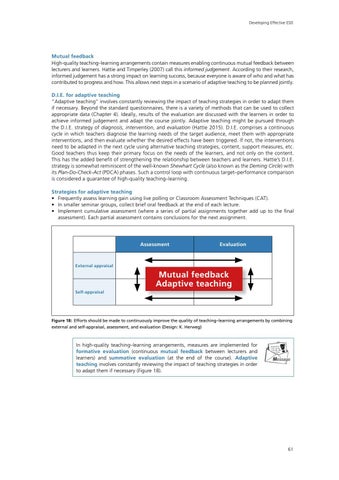Developing Effective ESD
Mutual feedback High-quality teaching–learning arrangements contain measures enabling continuous mutual feedback between lecturers and learners. Hattie and Timperley (2007) call this informed judgement. According to their research, informed judgement has a strong impact on learning success, because everyone is aware of who and what has contributed to progress and how. This allows next steps in a scenario of adaptive teaching to be planned jointly. D.I.E. for adaptive teaching “Adaptive teaching” involves constantly reviewing the impact of teaching strategies in order to adapt them if necessary. Beyond the standard questionnaires, there is a variety of methods that can be used to collect appropriate data (Chapter 4). Ideally, results of the evaluation are discussed with the learners in order to achieve informed judgement and adapt the course jointly. Adaptive teaching might be pursued through the D.I.E. strategy of diagnosis, intervention, and evaluation (Hattie 2015). D.I.E. comprises a continuous cycle in which teachers diagnose the learning needs of the target audience, meet them with appropriate interventions, and then evaluate whether the desired effects have been triggered. If not, the interventions need to be adapted in the next cycle using alternative teaching strategies, content, support measures, etc. Good teachers thus keep their primary focus on the needs of the learners, and not only on the content. This has the added benefit of strengthening the relationship between teachers and learners. Hattie’s D.I.E. strategy is somewhat reminiscent of the well-known Shewhart Cycle (also known as the Deming Circle) with its Plan-Do-Check-Act (PDCA) phases. Such a control loop with continuous target–performance comparison is considered a guarantee of high-quality teaching–learning. Strategies for adaptive teaching • Frequently assess learning gain using live polling or Classroom Assessment Techniques (CAT). • In smaller seminar groups, collect brief oral feedback at the end of each lecture. • Implement cumulative assessment (where a series of partial assignments together add up to the final assessment). Each partial assessment contains conclusions for the next assignment.
Assessment
Evaluation
External appraisal
Mutual feedback Adaptive teaching Self-appraisal
Figure 18: Efforts should be made to continuously improve the quality of teaching–learning arrangements by combining external and self-appraisal, assessment, and evaluation (Design: K. Herweg)
In high-quality teaching–learning arrangements, measures are implemented for formative evaluation (continuous mutual feedback between lecturers and learners) and summative evaluation (at the end of the course). Adaptive teaching involves constantly reviewing the impact of teaching strategies in order to adapt them if necessary (Figure 18).
61














